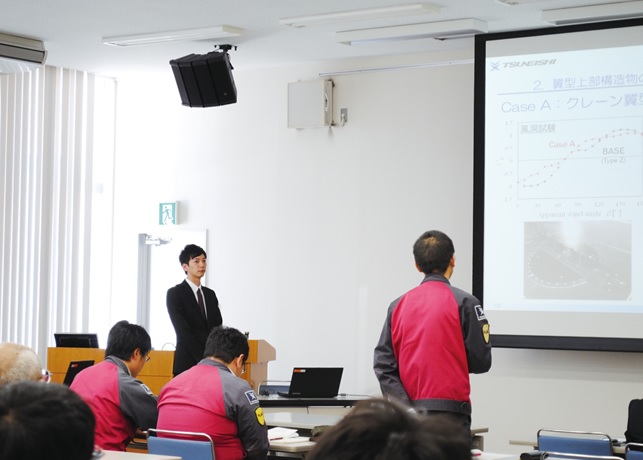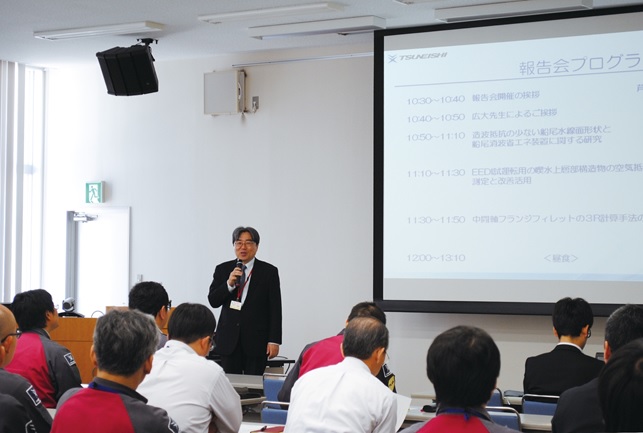Topics
TSUNEISHI presents the results of joint research with Hiroshima University
July 29, 2016
TSUNEISHI SHIPBUILDING Co., Ltd. (HQ: Fukuyama, Hiroshima, Japan) held a meeting on April 26, 2016 at the TSUNEISHI FACTORY to present the results of the joint research with Hiroshima University Graduate School of Engineering for the fiscal year 2015.
TSUNEISHI SHIPBUILDING Co., Ltd.
http://www.tsuneishi.co.jp
The joint research by TSUNEISHI SHIPBUILDING and Hiroshima University, launched in June 2004, has been conducted continuously for the last 12 years. Research activities are being conducted in the four fields of performance, structure, outfitting, and environment. Past research results have led to the development of a bow shape that reduces wave resistance and improves fuel effiency; propeller and rudder designs that transform the energy of the main engine to high propulsion efficiency and contribute to energy-saving; and the use of topology optimisation* (optimisation of configuration design) methods to develop stronger hull structures to achieve excellent safety levels. These results have been sequentially introduced in the construction of vessels. In addition, a 2012 paper studying the resonance phenomenon caused by the vibration of the anchor chain received the “Japan Society of Naval Architects and Ocean Engineers Research” Paper Award, further contributing to the advancement of academics in the maritime industry.
In the 2015 joint research report meeting, studies of the structural optimisation of hatch covers and a new shape for rudder carriers were announced:
(1) Structural optimisation of hatch covers
The aim of the research was to reduce the weight of the hatch covers by using an optimisation programme. Case studies were automatically conducted on depth, proportions, transverse frame position, longitudinal space, and cylinder position in the hatch covers. As a result, a programme to obtain the minimum weight was developed. This programme, combined with a structural analysis programme, led to the conclusion that a 9% reduction from the initial design was possible.
(2) Study of a new shape for rudderhead bearings (rudder carriers)
The rudder carriers, bolted to the deck of the steering gear chamber, support the weight of the ship as well as the counter-force of the rudder. As they are crucial to safe navigation, no significant design changes have been made in recent years. A review of the design was sought to reduce their weight with the aim of lowering costs. In this study, structural analysis was used to verifiy the strength of the rudder carriers and then new design proposals were developed using topology optimisation methods. As a result, a maximum reduction of 41.4% in the weight of the rudder carriers was achieved and the newly designed rudder carrier is now under development.
When the research results were announced, Professor Hironori Yasukawa from Hiroshima University Graduate School of Engineering commented, “We are pleased that this joint research has been continuing for 12 years in this way as part of the local contribution and collaboration between industry and academia required of universities. Currently, shipyards and design technology have matured, which means that research results can only be accumulated at the rate of 1% or 2%. However, on the other hand, when research is considered from the viewpoint of 10 years hence, the necessity for research becomes clear. This applies to the research themes of ‘optimisation’ and ‘systematisation’ using computers (artificial intelligence), which were much of our focus this time. Further improvements in how computers are used is becoming increasingly important, but I think that TSUNEISHI SHIPBUILDING can make great leaps forward, and stay ahead of their competitors, if we can quickly come up with new ways of thinking.”
TSUNEISHI SHIPBUILDING is continuing the joint research with Hiroshima University in 2016 and persevering in the challenge to produce a variety of methods to enhance environmental performance and improve the safety of shipbuilding.
*Topology optimisation methods: design techniques to determine the optimal layout in a certain area
– About TSUNEISHI SHIPBUILDING Co., Ltd. -
The TSUNEISHI GROUP was established in Hiroshima Prefecture, Japan around 113 years ago, with shipbuilding and shipping transport as its core business operations. A Group company and one of the foremost shipbuilders in Japan, TSUNEISHI SHIPBUILDING Co., Ltd. constructs about 60 vessels per year from its four shipyards; the TSUNEISHI FACTORY in Japan, and its production yards in the Philippines, China, and Paraguay. It produces mostly bulk carriers in the 30,000-180,000 ton range, as well as container and tanker vessels.
President: Kenji Kawano
Field of Business: Shipbuilding, Ship repair
Established: July 1917
Capital: 100 million yen
Employees: 756 (as of December 2015)
Business Locations: Tsuneishi Factory (Numakuma-cho, Fukuyama, Hiroshima, Japan)
URL:
TSUNEISHI HEAVY INDUSTRIES (CEBU), Inc.(Cebu, Philippines)
http://www.thici.com/
TSUNEISHI GROUP (ZHOUSHAN) SHIPBUILDING, Inc.(Zhejiang, China)
http://www.tsuneishi-zs.com/en/
TSUNEISHI IRON WORKS Co., Ltd. (Fukuyama, Hiroshima)
http://www.tsuneishi-iw.jp/
TSUNEISHI TRADINGS Co., Ltd. (Fukuyama, Hiroshima)
http://www.tsuneishi-tradings.co.jp/
TSUNEISHI ENGINEERING Co., Ltd. (Fukuyama, Hiroshima)
http://www.tsune-e.com/
For inquiries:
TSUNEISHI HOLDINGS CORPORATION
Marketing & Communications Group, CSV Division
pr@tsuneishi.com



